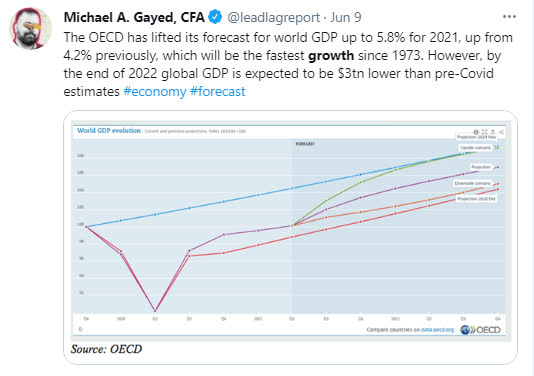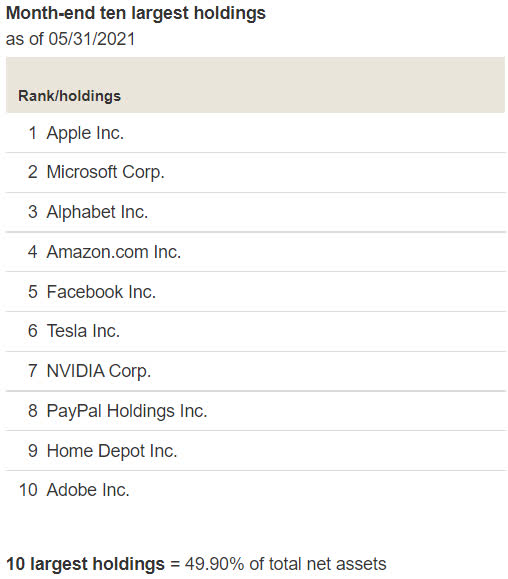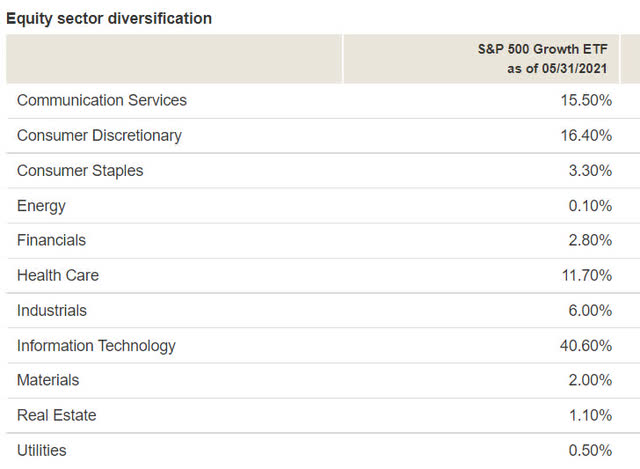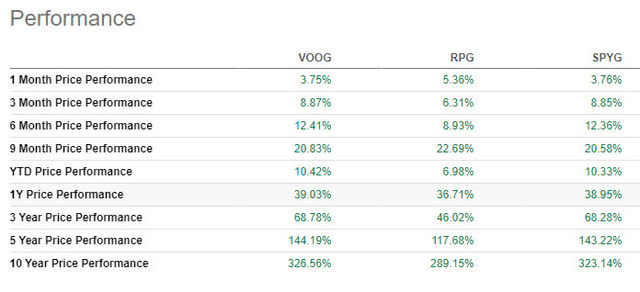I rated the Vanguard S&P 500 Growth ETF (VOOG) as bullish in January 2021 when it was floating around $230. Well, it is currently trading at $253 on June 16, 2021, up 10% in 5 months since this post. The ETF invests in large-cap growth stocks included in the S&P 500 Growth Index and tracks the returns of the index.
Well we are in a disruptive market where things are changing rapidly and as such we need to consider the following factors for all growth tools:
1. Although the Fed was less than hawkish at yesterday’s meeting and pledged to keep interest rates low through the end of 2022, there’s a good chance it will start scaling back asset purchases if inflation doesn’t cool off in the medium term. Therefore, bulls chasing growth stocks have a limited window to chase stocks that have already zoomed like crazy in 2020.

Image source: My tweet/The Lead Lag Report
2. Although the OECD has revised its global GDP growth forecast for 2021 upwards to 5.8% from 4.2%, it has also stated that global GDP by the end of 2022 would be $3 trillion lower than before the COVID growth estimates. Investors should read this as a signal that the stock market has priced in much of the future growth and isn’t as much on the table as it was in 2020.
That being said, I’m still bullish on VOOG in the medium to long term for the following reasons:
Portfolio and risk management

Image source: VOOG website
As of May 31, 2021, VOOG has its total assets invested in a basket of 238 stocks that have a price-to-earnings ratio of 34.8 and a price-to-book ratio of 9.9 — and those ratios make the ETF an expensive one Purchase. But growth stocks aren’t available at reasonable valuations these days. About 83% of the ETF’s total assets were parked in fast-growing sectors such as IT (41%), communications (16%) and consumer discretionary (16%).

Image source: VOOG website
About 50% of its total assets are invested in its top 10 holdings, which include the usual IT suspects like AAPL, FB, MSFT, and AMZN (see image above). That means about 50% of VOOG’s total assets are invested in 228 stocks, which in turn implies that the fund isn’t sufficiently risk-free and is very top-heavy. The ETF’s annual portfolio turnover ratio is 24% and from my last post I can see that the company has gained in IT, healthcare and communications stocks while reducing exposure to the industrials and financials sectors. The expense ratio is extremely low at 0.10%.
peer comparison

Image Source: Custom comparison at Seeking Alpha
VOOG has outperformed its peer ETFs like Invesco S&P 500 Pure Growth (RPG) and SPDR Portfolio S&P 500 Growth (SPYG). While VOOG has far outperformed RPG in the long run, its performance is only marginally better when compared to SPYG. Overall, it’s been the best performer over the long term and I believe it will continue to outperform its peers over the long term.
dividends
VOOG is a consistent dividend payer, but its expected yield doesn’t matter since it’s a growth ETF. It is not designed for income investors.
Anyway, for the record, the ETF paid out $2.19 in dividends in 2019 and about $2.03 in 2020. I believe it will pay out as much as $2 in dividends in 2021, giving it a tiny 0.79% dividend yield, a percentage that doesn’t matter much for a growth investor.
Sum up
I am very bullish on VOOG’s prospects in the long-term and moderately bullish in the medium-term as the Fed may start talking about tapering asset purchases, rate hikes, inflation, etc. and their words may dampen bullish sentiment in the medium-term. Still, immunizations are picking up speed, the economy is opening up and the government is likely to announce significant spending on infrastructure soon, all of which are positive signs.
Long- to intermediate-term investors looking for an ETF that gives them exposure to large-cap growth stocks may consider investing a portion of their funds in VOOG. However, short-term investors may avoid this due to the expected short-term volatility. Finally, income investors can stay away as this ETF just isn’t designed for them.

